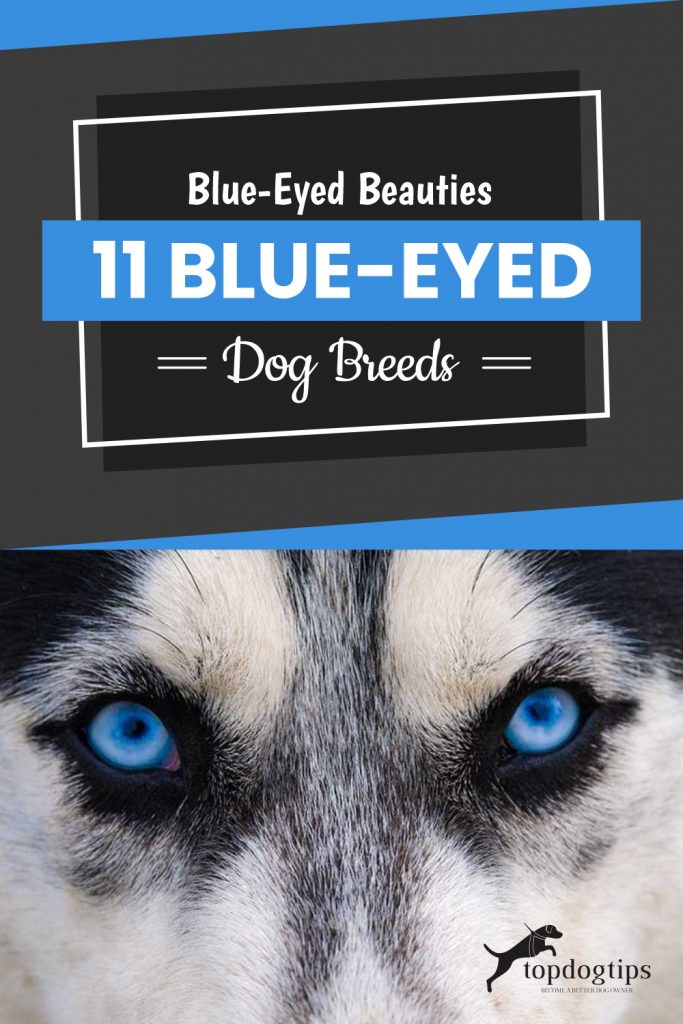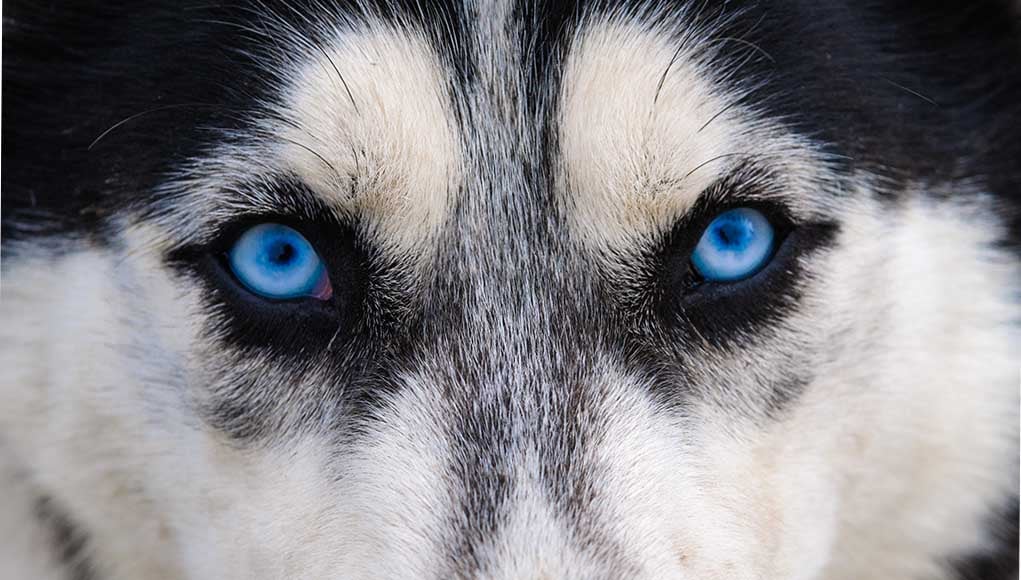Is it a rarity? Or the stark contrast to typical brown eyes? Whatever the reason, blue eyes on a dog’s face captivate us.
If you want to find a blue-eyed beauty of your own, check out the breeds described below. But first, let’s learn a little more about blue eyes in dogs.
What Causes Blue Eyes in Dogs?
Brown is the most common color for a dog’s eyes. Unlike with people, blue eyes in dogs is relatively rare. That distinctive eye color occurs for one of the following four reasons.
The dog has a rare “blue-eye” gene mutation.
Let’s head back to high school biology class for a quick review about genetics.
If one parent has a dominant gene for a certain trait, and another parent has a recessive gene for that trait, then the dominant gene prevails.
In both dogs and humans, the gene that causes blue eyes is recessive. Therefore, both canine parents must carry that recessive gene in order for their puppy to have blue eyes.
However, in some dogs like the Husky, the gene for blue eyes is dominant rather than recessive.
In a study done in 2018, scientists examined samples from DNA test kits for 6,000 different dogs.
In Siberian Huskies, they found a genetic mutation near the gene known as ALX4 on canine chromosome 18. That mutation was strongly associated with blue eyes in Huskies.
Researchers hypothesized that the mutation in that particular gene caused the Husky’s eyes to produce less pigment. The lack of pigment makes the eyes look blue.
Other dogs—such as Border Collies and tri-colored Australian Shepherds—can also have that dominant blue eye gene.
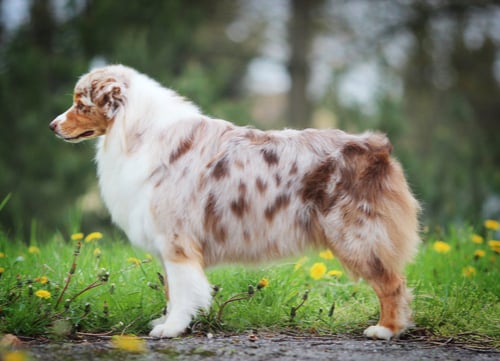
The dog carries the Merle gene.
The word “merle” describes a color pattern on the coat of some dogs. It’s typically bluish- or reddish-gray with splotches of black or reddish-brown.
The merle coat is caused by cells that are unable to produce pigment.
The so-called “Merle gene” can also affect the nose and eyes. Dogs with the Merle gene may have noses that are partly or entirely pink and blue eyes.
Many dog breeds—including Corgis, Dachshunds, Great Danes, Collies, and Merle Australian Shepherds, to name only a few—may carry this gene.
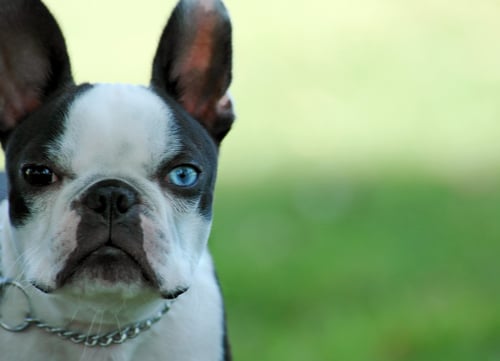
The dog doesn’t have pigment around one or both eyes.
Dog breeds that have significant patches of white fur on the face may produce dogs with blue eyes.
Because the fur can’t produce pigment around those areas, the nose, skin, and eyes may also be affected. The result may be blue eyes.
Examples of dog breeds in which white fur around the face may also result in blue eyes include Boxers, Collies, and Boston Terriers.
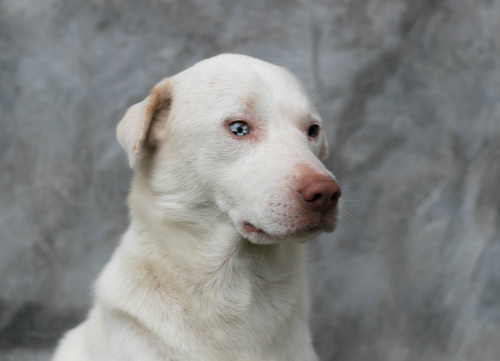
The dog is albino.
Albino dogs have very little pigment throughout their entire bodies, which results in white coats, pink noses, and blue or light amber eyes. They are quite rare.
Some breeds in which albino dogs have occurred include Great Danes, Collies, Labrador Retrievers, Schnauzers, and Pugs.
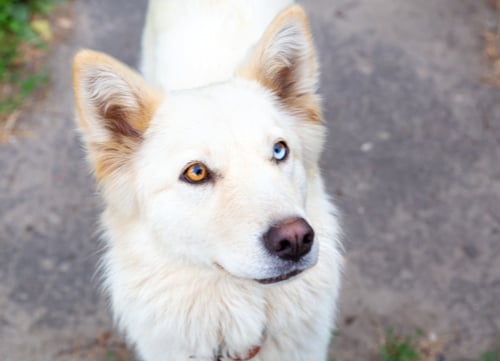
What about dogs with different-colored eyes?
A Native American myth claims that dogs with different-colored eyes can see both earth and heaven at the same time, which is a lovely idea.
That condition, with one blue eye and one eye of a different color, is called heterochromia. Caused by either gene variations or a lack of pigmentation, heterochromia occurs in cats, people, and horses as well.
Health Concerns with Blue-Eyed Dogs?
Some worry that blues eyes in dogs indicate underlying health issues.
For the most part, the only health issue related to a dog’s blue eyes, like a person’s, is increased sensitivity to sunlight and bright light. However, there are a couple of exceptions.
If two dogs that carry the merle gene are bred, their offspring are called “double merle.” Those puppies have a much greater risk of health problems, including deafness, blindness, or both.
For that reason, breeding merle carriers with other merle carriers is prohibited. As long as a carrier of the merle gene mates with a non-carrier, the offspring shouldn’t have any higher risk of blindness or deafness.
In Dalmatians, blue eyes can sometimes indicate the possibility of deafness, since the same gene that results in blue eyes is also connected with hearing loss.
If your dog’s eyes change to blue or become cloudy, this may indicate cataracts, glaucoma, or other eye disease, and you should consult with your veterinarian.
11 Dogs Famous for Their Baby Blues
Check out the following breeds if you’re interested in finding a blue-eyed dog.
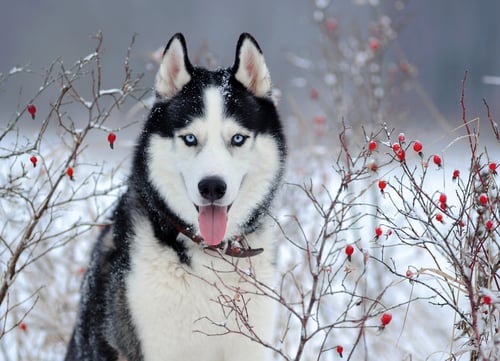
1. Siberian Husky
Blue eyes are relatively common in Siberian Huskies, as is heterochromia.
Around two out of five Siberian Huskies will have blue eyes, and about fifteen percent will have one brown eye and one blue eye.
Husky mixes and crossbreeds, like the Alaskan Klee Kai (Siberian and Alaskan Husky mix) and the Pomsky (Pomeranian and Husky), may also inherit blue eyes.
Bred by the indigenous Chukchi people of northeastern Asia as both sled dogs and companions, Siberian Huskies have a compact, muscular body and thick fur.
They became public favorites in 1925 when relay teams of Siberian Huskies raced 658 miles across Alaska in five and a half days to deliver lifesaving serum to the city of Nome, where a diphtheria epidemic had struck.
Siberian Huskies are loyal, with a reputation for mischief. As a pack animal, they get along well with other people and dogs.
Since they are working dogs and were bred to pull sleds in the arctic they require a more specific diet. They are quick to chase small animals and need lots of room in a fenced yard to run.
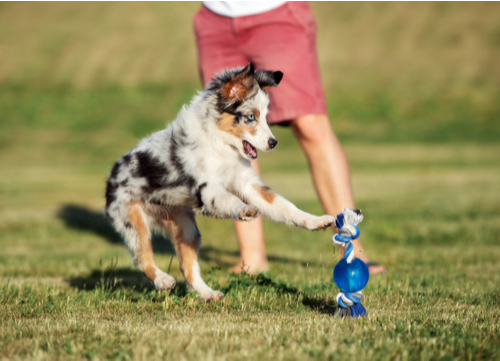
2. Australian Shepherd
Also called Australian Sheepdogs, these smart, focused dogs didn’t come from Australia.
Bred originally to herd livestock in the Pyrenees Mountains between France and Spain, the ancestors of the present-day Australian Shepherd traveled with their owners when they emigrated to Australia to herd sheep.
The new immigrants bred their herding dogs with Collies and Border Collies, resulting in the Australian Shepherds we recognize today.
Blue eyes can appear in both the merle and tri-colored shepherds. The crossbreed Aussiedoodle (Australian Shepherd and Poodle) may also inherit those baby blues and shed less than Australian Shepherds.
Australian Shepherds are keenly interested in doing work. They will herd dogs, children, and even birds. With their intelligence, they respond well to training but need an active owner and lots of exercise every day.
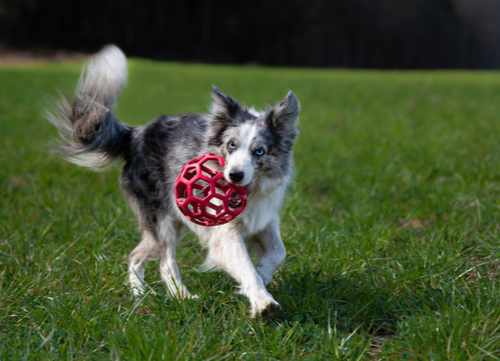
3. Border Collie
Blue eyes occur regularly in Border Collies, probably the best herding dogs in the world. They have dominated herding competitions in the United Kingdom for the last hundred years.
Highly intelligent and trainable, this dog is also tireless. If they are not working, then they need a secure space to run and lots of exercise every day.
The ideal dog for active owners, Border Collies excel in herding, obedience, agility, and tracking competitions. Like the Australian Shepherd, they will herd both animals and people.
These dogs need early socialization, ongoing training, and enrichment activities. Loving and loyal to family, they are reserved with people they don’t know.
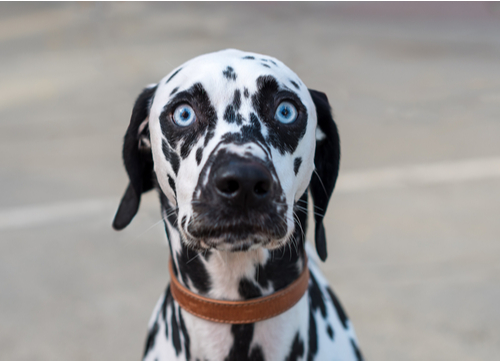
4. Dalmatian
Thanks to Disney, nearly everyone recognizes these dogs with their distinctive spotted coat. Originally bred to guard horses and carriages, Dalmatians have also accompanied firefighters on their trucks.
Today, these dogs still join the Budweiser Clydesdales in their parades.
With their energy level and stamina, Dalmatians require regular exercise. They make good running or hiking partners.
Blue eyes appear regularly in this breed. Unfortunately, the lack of pigment-producing cells that produce blue eyes may also cause hearing loss. Dalmatians with small, scattered spots and blue eyes are at the highest risk for deafness.
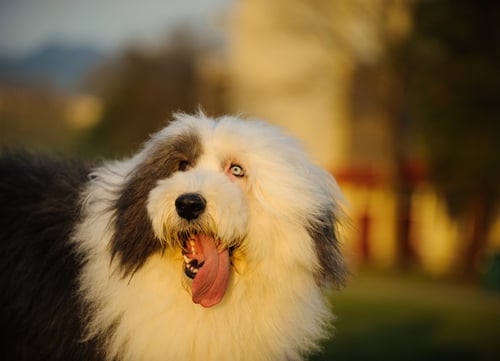
5. Shetland Sheepdog
Also called Shelties, these dogs were bred in Scotland’s rugged Shetland Islands to herd livestock.
Shelties adapt well to family life and enjoy outings with their people. They also excel in many canine activities and sports. Reserved with strangers, Shelties make good watchdogs, barking to alert the family.
Like other herding dogs, Shelties chase small animals, so they need to be walked on a leash and run in a fenced-in yard.
Shelties can carry the merle gene, which can result in the striking merle coat and blue eyes. Shelties often have heterochromia, where one eye is blue, and the other is brown or amber.
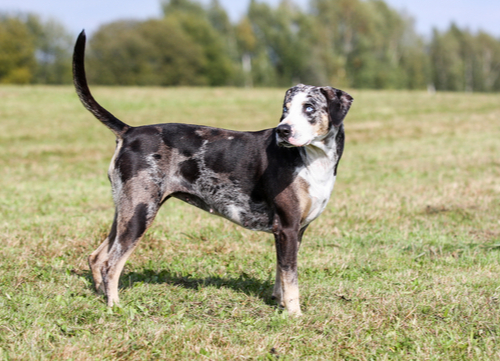
6. Catahoula Leopard Dog
This breed originated in Louisiana, and the word “Catahoula” is Choctaw for “sacred lake.” They were bred to herd livestock. These dogs developed a one-of-a-kind way of herding.
Working together, Catahoulas encircle the herd in a “dog fence” and then hold them there for their owner. Today, Catahoulas also serve as companions, watchdogs, and guard dogs. The Catahoula Leopard Dog is the State Dog of Louisiana.
Catahoulas have a high energy level and need lots of exercise. They are great swimmers, hikers, and retrievers. They also do well in agility sports.
Catahoulas have an independent streak, so early socialization and ongoing training are key to helping them fit into the family and remain mentally stimulated.
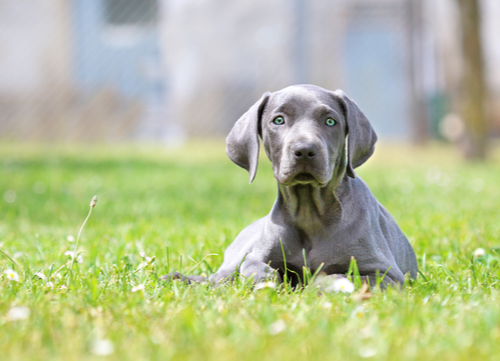
7. Weimaraner
Also called “Gray Ghosts,” these dogs have a silvery gray coat. Blue-gray eyes regularly appear in this breed.
Originating in Germany, these dogs were bred by Grand Duke Karl August in the early 1800s as he tried to create the perfect hunting dog.
Crossed with Bloodhounds and German and French hunting dogs, the Weimaraner worked as a pointer and retriever. The name of the breed comes from Weimar, a town in Germany where the duke lived.
Friendly and affectionate, Weimaraners are good with children and love being part of a family. Fast learners, they pick up both good and bad behaviors quickly, so early socialization and training are must-haves for them. They also need a lot of exercise and enough room to really run.
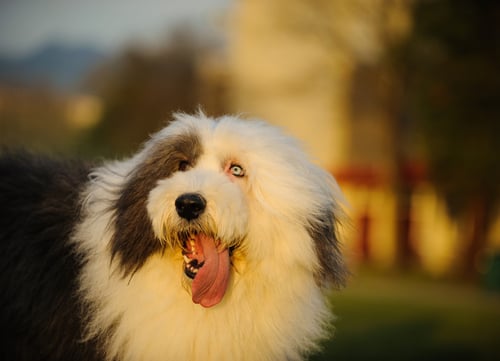
8. Old English Sheepdogs
Although you may not always see the blue eyes behind this dog’s shaggy mop, sometimes they are there. These sheepdogs may also have one blue eye and one dark brown one.
As the name implies, these dogs were bred in England, in Devon, Somerset, and Cornwall. Surprisingly, their purpose originally was to drive cattle to market, not to herd sheep.
Although they look like big, gentle bears, these dogs are surprisingly agile. Good with children, they are patient and protective.
They also make effective watchdogs with their loud bark. While they do need regular exercise, they’re also happy to spend quiet time with their people.
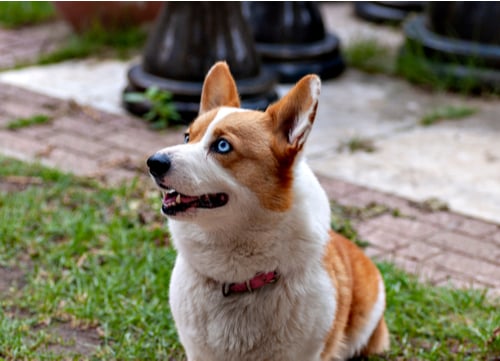
9. Pembroke Welsh Corgis
World famous as Queen Elizabeth II’s favorite dog, these small, powerful, low-to-the-ground dogs were bred to herd cattle and sheep.
They fit well into a family as companion dogs and enjoy playtime. Corgis are also effective watchdogs with a bark much bigger than their size.
They need moderate daily exercise, usually in the form of walks. They also excel at herding, agility, and obedience competitions. Outgoing, friendly dogs, they respond well to training.
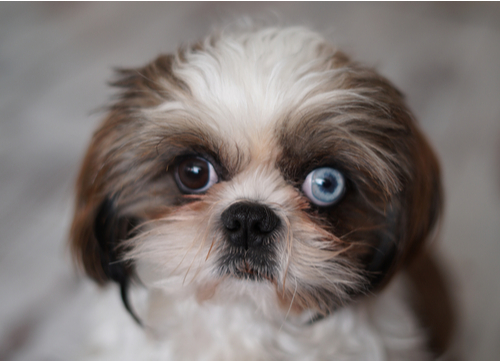
10. Shih Tzu
The Shih Tzu breed is centuries old, developed as a companion dog for Chinese emperors and their families. The name “Shih Tzu” means “lion.”
The perfect lap dog, the Shih Tzu, is happy to hang out with you at home. This breed is affectionate and playful, especially with children.
Its beautiful, long, silky double coat requires daily brushing, but the dog doesn’t shed much. Bred to be companion dogs, Shih Tzus doesn’t need a lot of exercise.
Daily short walks and playtimes are enough. Because of their charming, outgoing natures, training can be a challenge. They are skilled in getting their way with indulgent owners.

11. Dachshunds
Dachshund coats come in a number of colors, including blue merle, and that merle gene also allows for blue eyes to occur.
Bred in Germany as a hunting dog around six hundred years ago, the word “dachshund” translates to “badger dog.” The breed’s long body and short legs allowed it to dig into badger dens to reach its prey.
While friendly and curious, Dachshunds are also stubborn and can be hard to train. It’s important not to overfeed these dogs or give them high-fat foods. The extra weight puts a strain on their long backs. Daily walks will also help to keep their backs healthy and strong.
A Little Luck
In theory, because of recessive genes for blue eyes, most dog breeds should be able to produce puppies with those startling baby blues.
However, it’s still a rare occurrence. Maybe just a bit of good fortune is needed, which shouldn’t be surprising: blue eyes, after all, are supposed to be a sign of good luck.
Read Next: New DNA Test Finds Answers to Why Siberian Huskies Have Blue Eyes
